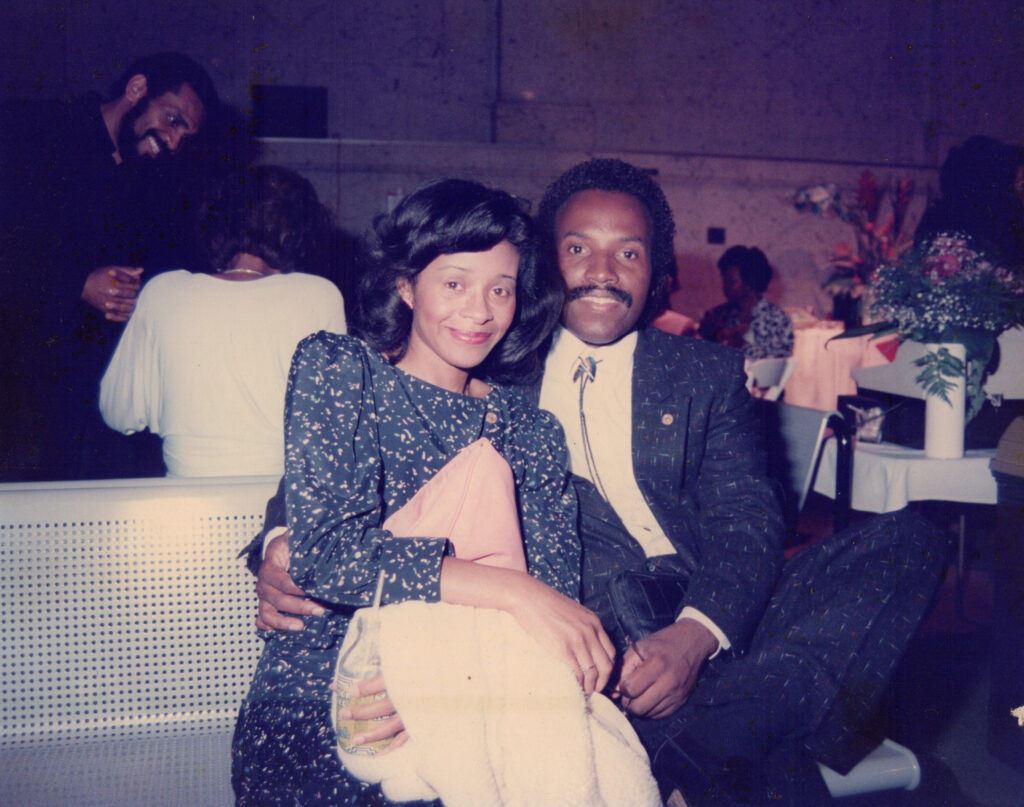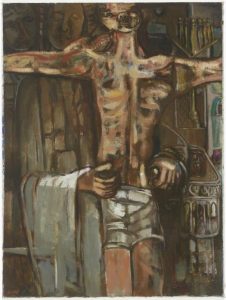Tag: African American art history
Richard Wyatt, Jr.: A Blessed Life of Art and Music
In February 2023, Dr. Bridget Cooks and I had the pleasure of interviewing the Los Angeles-based visual artist and songwriter Richard Wyatt, Jr., for the Getty Research Institute’s African American Art History Initiative. Wyatt was a joy to interview, making us laugh constantly and sharing what he called Forrest Gump moments, where he was in the right place at the right time to meet and collaborate with celebrities of all stripes.
A little over a year after this delightful interview, Bridget and I were saddened to hear that Richard had passed away in May 2024. The world has lost a kind and funny man, as well as an talented artist, musician, educator, and thinker.
While I continue to mourn Richard’s passing, I also want to celebrate his life by highlighting the wonderful stories he shared in his oral history about life, art, music, and seeking new challenges.

Richard Wyatt, Jr., was an artist whose work includes drawings, paintings, installations, and public art. Wyatt was born in Lynwood, California, in 1955, and lived in the Los Angeles area his whole life. He began his art career early, winning the Watts Chalk-In at twelve years old, and then studying at the Watts Towers Art Center, the Chouinard Art Institute, and the Tutor/Art Program with artist Charles White. Wyatt attended the University of California, Los Angeles, where he earned a BFA in art. Some of his best-known work in Los Angeles includes the mural Hollywood Jazz: 1945-1972 on the Capitol Records Building; the mural City of Dreams, River of History in Union Station; and the installation Ripple of Hope at Robert F. Kennedy Inspiration Park. Wyatt taught drawing and painting at the University of California, Irvine; the Otis Art Institute; and the Watts Towers Art Center. He also had a career as a songwriter, writing songs for musicians like The Miracles, The Sylvers, and New Edition.
One thing that continues to strike me about Richard is the indelible mark he has left on the world—and I mean that literally. Some of Richard’s best-known work was his public art, which adorned buildings and other public places in the Los Angeles area and beyond. For this reason, Bridget found interviewing Richard almost surreal. In the oral history, she explained, “…your work is part of my Los Angeles,” for indeed, Richard’s public art shaped the city in which she grew up. After our first day of interviews, Cooks and I drove around Downtown Los Angeles, pointing out and visiting sites where Richard’s work dotted the landscape: Union Station, Robert F. Kennedy Inspiration Park, the Capitol Records Building, and on and on.

One of Richard’s most famous murals, Hollywood Jazz: 1945-1972, remains on the Capitol Records Building, although he later replaced the paint on this south-facing exterior wall with ceramic tile to combat the ravages of the sun. When Richard accepted the commission for this work, it was the perfect blend of his love of visual art and his passion for music. In this mural, he memorialized jazz greats, such as Billie Holiday, Ella Fitzgerald, Miles Davis, and Nat King Cole. And in one of those Forrest Gump moments, Richard met musician Bonnie Raitt on site at the Capitol Records Building during his original installation. Listen as Richard recounted this moment:
Richard also mused about the role of an artist after unveiling a work of public art, sharing his thoughts on the impact of his public work: “…you can’t control it…Once it’s out there, it’s out there. People are going to interpret it and take pictures.” And while we spoke about the joys of creating art for wide public consumption, Richard also acknowledged some of the challenges inherent in this work. Listen as Richard shared about some of his public art work with collaborator and fellow artist May Sun:
Richard’s talent also extended to music, and resulted in a prolific career as a songwriter for musical artists such as The Miracles, The Sylvers, Peaches & Herb, Tavares, Johnny Gill, and New Edition. Richard wrote his first song, “Keep on Keepin’ On (Doin’ What You Do)” for The Miracles when he was just eighteen years old. But for Richard, visual art and music were always intertwined, as he experienced synesthesia, a sensory condition in which, among other things, allows some people see colors when they hear music. Richard explained his synesthesia this way:
“I didn’t even know that term until somebody else told me…When I’m writing, that’s one thing. But once I start arranging it and getting the bass and guitar, and then you get strings and horns, there are certain sounds that have a color associated with them. I can’t explain it, but…I see colors once I hear a certain sound, you know? And when I’m creating the arrangements, or even mixing or whatever, and I’m going for a certain effect, it’s like once you get mixing, to me it’s like glazing in oil. That’s the easiest way I can explain it.”
Richard was a child prodigy who burst into the art world when he was twelve years old, rubbing elbows with more experienced art world talents like Charles White, John Riddle, George Evans, and Bill Pajaud. Yet, Richard carved out a career all his own. And while he left us too soon, Richard’s art lives on. To celebrate this remarkable man and artist, I suggest spending time in Downtown Los Angeles and experiencing the work of Richard Wyatt, Jr., for yourself.
To learn more about Richard Wyatt, Jr.’s, extraordinary life and work, explore his oral history!
About the Oral History Center
The Oral History Center of The Bancroft Library preserves voices of people from all walks of life, with varying political perspectives, national origins, and ethnic backgrounds. We are committed to open access and our oral histories and interpretive materials are available online at no cost to scholars and the public. You can find our oral histories from the search feature on our home page. Search by name, keyword, and several other criteria. Sign up for our monthly newsletter featuring think pieces, new releases, podcasts, Q&As, and everything oral history. Access the most recent articles from our home page or go straight to our blog home.
David C. Driskell: Life Among the Pines
In April 2019, Dr. Bridget Cooks and I had the privilege of conducting a series of oral history interviews with artist and educator David C. Driskell for the Getty Research Institute’s African American Art History Initiative. David and his wife, Thelma, welcomed us into their home, where we spent hours speaking with David about his singular life and extraordinary contributions to art and African American art history. It was a surreal experience to sit behind the camera and look around at beautiful works of art while David skillfully engaged us with stories from his life and work. In recounting his past, David employed accents and well-timed jokes that had us in stitches. It was a pleasure to watch a gifted storyteller at work.
One year later, I learned from Bridget that this kind, funny, and smart man had passed away from complications due to the coronavirus on April 1, 2020. In a year filled with so much loss and change, David’s passing still hit hard. With David’s passing, the world lost not only a bright personality, but also a brilliant mind who championed the field of African American art history. And despite the uncertainty of these early days of the pandemic, I am happy to say that the Oral History Center was able to expedite the finalization of David’s oral history transcript, which is now available to the public.
Now another April has arrived. At the Oral History Center our work remains remote, but people across the country have been vaccinated against the coronavirus, and there is hope that the end of the pandemic is in sight. It is past time to take stock and reflect on those we have lost and the stories that remain with us. For me, David Driskell’s interview is one such story with staying power.
David C. Driskell was an artist and professor of art. He was born in Georgia in 1931, but mainly grew up in North Carolina. Driskell graduated from Howard University with a degree in painting and art history in 1955, attended the Skowhegan School of Painting and Sculpture in 1953, and earned an MFA from Catholic University in 1962, as well as a study certificate in art history from Rijksbureau voor Kunsthistorische Documentatie in 1964. Beginning in 1955, he taught at several colleges, including Talladega College; Howard University; Fisk University; and the University of Maryland, College Park. His influential artwork includes Young Pines Growing, Behold Thy Son, Of Thee I Weep, and Ghetto Wall #2. Driskell has curated important shows highlighting African American art history, including Two Centuries of Black American Art and Hidden Heritage: Afro-American Art, 1800-1950. He also helped establish The David C. Driskell Center for the Study of Visual Arts and Culture of African Americans and the African Diaspora at the University of Maryland, College Park, in 2001. Find this interview and all our oral histories from the search feature on our home page. You can search by name, key word, and several other criteria.
Throughout his many years making art, David experimented with different media and subjects, often with the recurring theme of pine trees. Yet one of his most memorable pieces is Behold Thy Son from 1956, which is now at the Smithsonian’s National Museum of African American History and Culture. David painted this pietà – a subject in Christian art depicting the Virgin Mary cradling the dead body of Jesus – in response to the 1955 murder of Emmett Till. For many observers, this image captured the zeitgeist of the early Civil Rights movement.

Listen as David speaks about making this important piece:
When Bridget asked how David felt about Behold Thy Son over sixty years after painting it, he replied, “I think it is dated and tied to a time and period, but the fight goes on. It’s also showing you that time hasn’t changed that much. [Eric Garner and] ‘I can’t breathe.’ ” Indeed, the subject of violence against Black bodies remains tragically evergreen.
And yet, in part because of this turmoil for African Americans at midcentury, David found renewed artistic inspiration in the serenity of nature – especially pine trees. Listen as he explains this shift in his work:
David was indeed a talented artist and important educator, as Bridget eulogized so well in her obituary on ArtForum last year. But our oral history interviews with him also highlighted the fact that he was a deeply religious man, one who connected his spirituality and creativity with his passion for gardening. During an interview session after church on Palm Sunday, David said of these links between nature and religion, “From dust and dirt thou came, and so dust to dirt thou goest. I’ve got to be part of that process.”
He further explained:
“So gardening is to me like painting, in a way. It’s a part of the process of this creative spirit that I feel so close to. Can’t wait to get [to the house in Maine] and I often go to the garden before I go to the studio…Gardening is a part of my life. It’s a part of that kind of spiritual regeneration that comes with the natural process. It isn’t for me so much the biblical reference.”
As a further measure of the man, when we were wrapping up our final interview session, we asked David for his concluding thoughts, and he said, “Well, maybe the final say is none of this I could be doing without family.” He went on to praise his wife, Thelma, in particular for supporting his art career when it was just a dream.
To learn more about David C. Driskell’s extraordinary life and work, read his oral history transcript and watch his interview in full here, here, and here. Find this interview and all our oral histories from the search feature on our home page. You can search by name, key word, and several other criteria.